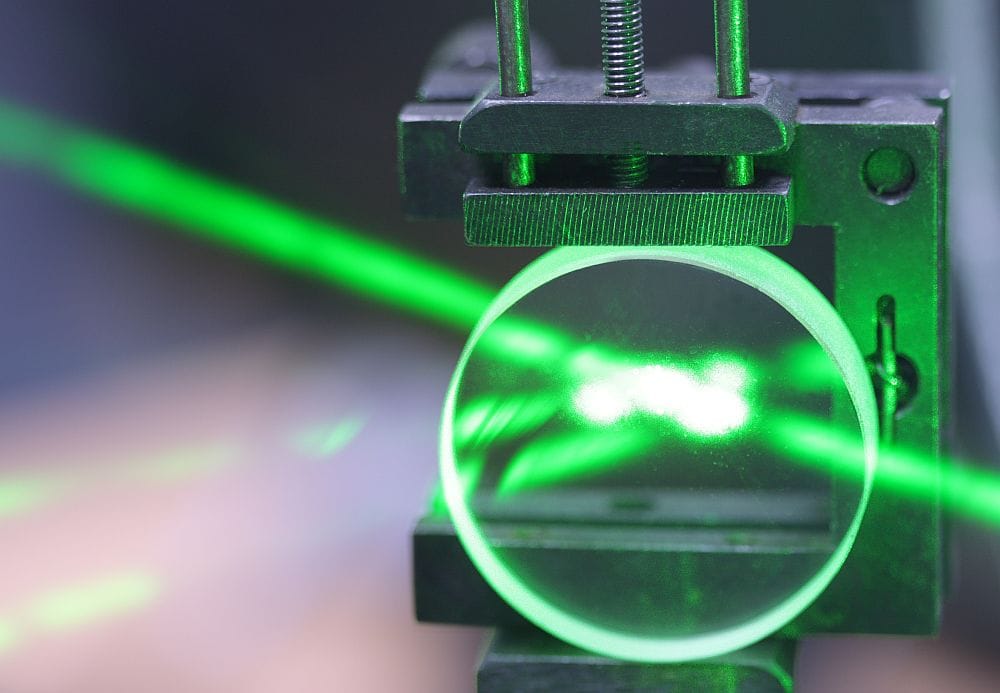
[Image above] First stage of the SpaceX Falcon 9 rocket successfully landing on an autonomous spaceport drone ship in April 2016. Ultrahigh-temperature ceramics are expected to play a key role in future aerospace technologies, for example, as shielding on the leading edges of hypersonic vehicles. Credit: SpaceX, Wikimedia (CC0 1.0)
The stars have guided and inspired humanity for thousands of years, but it is only within the last century that people made the leap from Earth-based observations to outer space travel. Ceramic materials played a central role in this momentous transition, and they will continue to serve as essential components in aeronautic and astronautic technologies as we travel faster and further into space.
Ultrahigh-temperature ceramics (UHTCs) are a promising class of materials for such applications. These refractory ceramics have the formulation M–X, where M is an early transition metal (groups 4–5 of the periodic table) and X is either a boron, carbon, or nitrogen. They have very high melting temperatures (>3,000°C) as well as other useful thermomechanical properties.
UHTCs were first reported in the late 19th century, but it was the U.S.–Soviet Union space race in the mid-20th century that kicked off systematic study of these materials. UHTCs are now used in various commercial applications, such as the Hall-Héroult aluminum production process and boiling water nuclear reactors. Researchers expect UHTCs will expand into other extreme environment applications, including hypersonics and space travel.
Considering this potential, “we believe that it is timely to provide a focused perspective on the relation among atomic-scale fundamentals, oxidation behavior, processing parameters, and future opportunities for scientific advancement of UHTCs for use in extreme environment applications,” researchers write in a new paper.
ACerS member Babak Anasori, Reilly Rising Star Associate Professor of Materials and Mechanical Engineering at Purdue University, is senior author on the new paper. He wrote the paper with his students Brian C. Wyatt and Srinivasa Kartik Nemani along with ACerS Fellows Gregory E. Hilmas (Missouri University of Science and Technology) and Elizabeth J. Opila (University of Virginia).
Highlights from their 18-page review paper, which is the first article on UHTCs published in Nature Reviews Materials, are given below.
UHTC bonding fundamentals
The authors begin the review by diving into the structural characteristics of UHTCs, specifically the bonding structure.
There are three main chemical bonds at play in UHTCs: transition metal to boron/carbon/nitrogen (M–X), transition metal to transition metal (M–M), and nonmetal to nonmetal (X–X).
This mixture of ionic, covalent, and metallic bonds within one system can greatly impact the stability of the cubic (carbide or nitride) or hexagonal (diboride) crystal structure, depending on the ratio of each bond type. But in general, “the ionic character of ionic and covalent M–X bonds and the reduction of the number of antibonding M states are the dominant contributors to the stability that support increased melting temperatures in UHTC systems,” the authors write.
High-temperature oxidation behavior of UHTCs
High-temperature applications of UHTCs typically involve high speeds and corrosive conditions as well. Such environments increase the possibility of chemical reactions taking place, such as oxidation. Understanding the mechanisms that drive oxidation can help researchers design more chemically resistant UHTCs.
In general, UHTCs have a thin native oxide scale that prevents oxidation of the material in ambient conditions. However, as temperature increases, both the M and X components in UHTC systems continuously form oxides species past the native oxide, which affects the mechanical and thermal integrity of UHTCs.
The authors provide detailed descriptions of the different oxide species that form in several UHTCs. Overall, transition metal diborides demonstrate superior oxidation behavior compared with transition metal carbides and nitrides, and thus are preferred for hypersonic and space exploration applications.
UHTC synthesis and additives
The authors turn their attention to UHTC synthesis in the paper’s third section. While there are multiple approaches to synthesizing UHTCs, including solid-state reactive synthesis and solution-derived synthesis processes, the final UHTC’s quality is most influenced by two key characteristics of the starting powders: particle size and impurity content.
The authors note that sintering UHTCs to full density in their monolithic forms is difficult due to the strong covalent nature of the M–X bonds. As such, additives in the form of alloying or doping can help promote densification, as well as provide structural and functional enhancements.
The most common additives used can be classified into three types: 3D particles, fibers, and lower-dimensional materials. The authors overview the pros and cons of each additive type.
Future perspectives
In addition to research on traditional UHTC synthesis and manufacturing methods, some novel techniques are being used to develop UHTCs, including 3D printing, machine learning and modeling, high-entropy composition design, and 2D fabrication (e.g., MXenes).
This research on both traditional and novel manufacturing methods “will help the development of new UHTC materials to see humanity into the next era of technological breakthroughs in extreme environment scenarios,” the authors conclude.
The paper, published in Nature Reviews Materials, is “Ultra-high temperature ceramics for extreme environments” (DOI: 10.1038/s41578-023-00619-0).
Author
Lisa McDonald
CTT Categories
- Aeronautics & Space
- Education
- Thermal management


